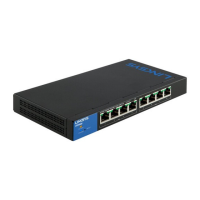64
Table of Contents
Linksys
Overview
The Internet Protocol version 6 (IPv6) is a network-layer protocol for
packetswitched Internet works. IPv6 was designed to replace IPv4, the
predominantly deployed Internet protocol.
IPv6 introduces greater flexibility in assigning IP addresses because the
address size increases from 32-bit to 128-bit addresses. IPv6 addresses are
written as eight groups of four hexadecimal digits, for example FE80:0000:0
000:0000:0000:9C00:876A:130B. The abbreviated form, in which a group of
zeroes can be left out, and replaced with ‘::’, is also acceptable, for example,
::-FE80::9C00:876A:130B.
IPv6 nodes require an intermediary mapping mechanism to communicate with
other IPv6 nodes over an IPv4-only network. This mechanism, called a tunnel,
enables IPv6-only hosts to reach IPv4 services, and enables isolated IPv6 hosts
and networks to reach an IPv6 node over the IPv4 infrastructure.
The device detects IPv6 frames by the IPv6 Ethertype.
IPv6 Interface
An IPv6 interface can be configured on a port, LAG or VLAN.
To define an IPv6 interface:
STEP 1 Click Configuration > IP Interface> IPv6 > IPv6 Interface.
STEP 2 Click Add to add a new interface on which interface IPv6 is enabled.
STEP 3 Enter the fields:
• IPv6 Interface—Select a specific port, LAG, ISATAP tunnel or VLAN for the
IPv6 address.
• Number of DAD Attempts—Enter the number of consecutive neighbor
solicitation messages that are sent while Duplicate Address Detection
(DAD) is performed on the interface’s Unicast IPv6 addresses. DAD verifies
the uniqueness of a new Unicast IPv6 address before it is assigned. New
addresses remain in a tentative state during DAD verification. Entering
0 in this field disables duplicate address detection processing on the
specified interface. Entering 1 in this field indicates a single transmission
without follow-up transmissions.
• IPv6 Address Auto Configuration—Select to enable automatic address
configuration from router advertisements sent by neighbors.
NOTE:
The device does not support stateful address autoconfiguration from a
DHCPv6 server.
• Send ICMPv6 Messages—Select to enable generating unreachable
destination messages.
STEP 4 Click Apply to enable IPv6 processing on the selected interface.
Regular IPv6 interfaces have the following addresses automatically
configured address
• All link local Multicast addresses (FF02::1)
• Solicited-Node Multicast address (format FF02::1:FFXX:XXXX)
IPv6 Interface Addresses
To assign an IPv6 address to an IPv6 Interface, do the following:
STEP 1 Click Configuration > IP Interface> IPv6 > IPv6 Interface Addresses.
STEP 2 To filter the table, select an interface name, and click Search. The
interface appears in the IPv6 Address Table.
STEP 3 Click Add.
STEP 4 Enter values for the fields.
• IPv6 Interface—Displays the interface on which the IPv6 address is to be
defined. If an * is displayed, the IPv6 interface is not enabled but has been
configured.
• IPv6 Address Type—Select the type of the IPv6 address to add.
• Link Local—An IPv6 address that uniquely identifies hosts on a single
network link. A link local address has a prefix of FE80, is not routable, and
can be used for communication only on the local network. Only one link
local address is supported. If a link local address exists on the interface, this
entry replaces the address in the configuration.
• Global—An IPv6 address that is a global Unicast IPV6 type that is visible
and reachable from other networks.

